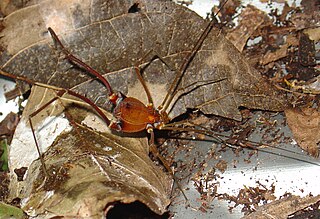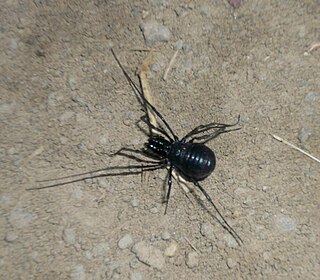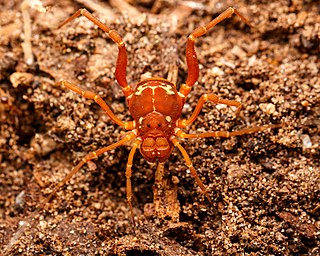
The Opiliones are an order of arachnids colloquially known as harvestmen, harvesters, harvest spiders, or daddy longlegs. As of April 2017, over 6,650 species of harvestmen have been discovered worldwide, although the total number of extant species may exceed 10,000. The order Opiliones includes five suborders: Cyphophthalmi, Eupnoi, Dyspnoi, Laniatores, and Tetrophthalmi, which were named in 2014.

The Pholcidae are a family of araneomorph spiders. The family contains more than 1,800 individual species of pholcids, including those commonly known as cellar spider, daddy long-legs spider, carpenter spider, daddy long-legger, vibrating spider, gyrating spider, long daddy, and skull spider. The family, first described by Carl Ludwig Koch in 1850, is divided into 94 genera.

Opilio is a genus of harvestmen with 35 known species.

Gonyleptoidea is the most diverse superfamily of the Grassatores. It includes around 2,500 species distributed in the Neotropics. They are characterized by the simplified male genitalia, with the glans free subapical in the truncus.

Cosmetidae is a family of harvestmen in the suborder Laniatores. With over 700 species, it is one of the largest families in Opiliones. They are endemic of the New World with a Nearctic-Neotropical distribution where a large fraction of the diversity of Opiliones are represented by this single family. Cosmetidae have the northern extent of their range into the USA, where a small number species occur in the southern states. However, the family is especially diverse in Mexico, Central America and northern South America; especially the Andean realms. Their range also extends further south into Argentina and southern Brazil, but they are absent in Chile. Cosmetidae are prevalent in Amazonian region, but only relatively few also occur in Brazilian Atlantic Forest. Several species are also found in the Caribbean.

The Phalangiidae are a family of harvestmen with about 380 known species. The best known is Phalangium opilio. Dicranopalpus ramosus is an invasive species in Europe.

The Sclerosomatidae are a family of harvestmen with about 1,300 known species. One former subfamily has been recently removed to form a new family, Globipedidae.

Trogulidae is a family of harvestmen comprising 65 extant species in five genera.

Ischyropsalididae is a family of harvestmen with 35 described species in 3 genera, found in Europe and North America.
Graecophalangium is a genus of harvestmen in the family Phalangiidae.

Metaphalangium is a genus of harvestmen in the family Phalangiidae.

Platybunus is a genus of harvestmen in the family Phalangiidae.
Caelopyginae is a neotropical sub-family of harvestmen in the family Gonyleptidae.
Caelopygus is a genus of harvestmen found solely in Brazil. It is placed in the sub-family Caelopyginae, and includes two species formerly placed in the genera Liarthrodes Mello-Leitão, 1922 and Heterarthrodes Mello-Leitão, 1935:

Ischyropsalis is a genus of harvestmen in the monotypic family Ischyropsalididae, with 24 described species. They are found in Europe.
Cosmetinae is a subfamily of harvestmen in the family Cosmetidae.

Cynorta is a genus from the subfamily Cynortinae. The genus was first described by Carl Ludwig Koch.

Cynortinae is a subfamily of harvestmen in the family Cosmetidae.
Flirteinae is a subfamily of harvestmen in the family Cosmetidae.
Asarcus is a genus of harvestmen in the family Gonyleptidae with four described species. All species are found in Brazil.













